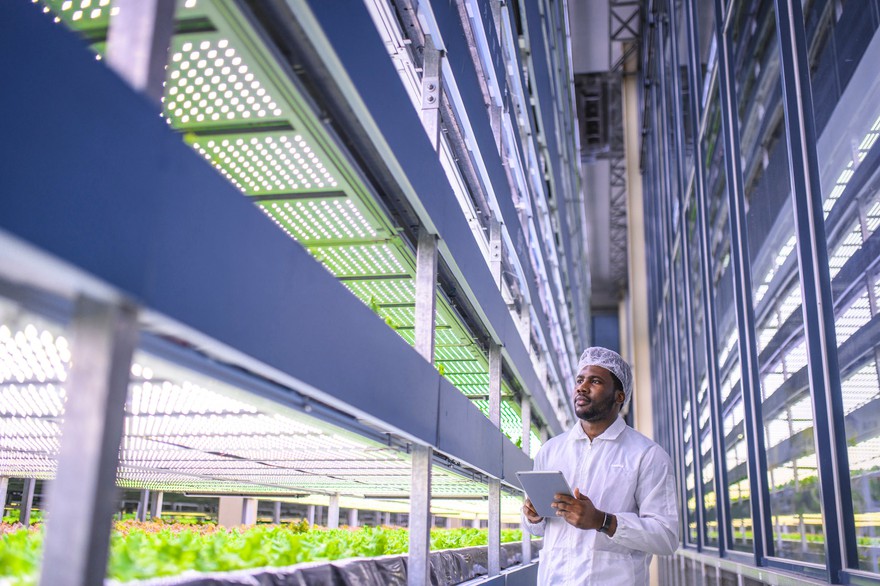Agriculture is a life-sustaining operation, and there are numerous ways for investors to own a piece of the action.
Like much of the global economy, the agricultural industry is sensitive to a wide range of global events, including wars, natural disasters, and political turmoil. Given that, the industry has been volatile as the war in Ukraine has occasionally squeezed the supply of products such as wheat and fertilizers.

Agribusiness is big business and touches on a wide array of industries. The scale required for operations has led to market power being concentrated in a handful of titans after a number of mergers and acquisitions. These companies -- many with healthy profits, cash flows, and dividends -- offer excellent opportunities for investors.
Top eight agriculture stocks to invest in 2025
Investors can choose among companies providing agricultural products and services such as fertilizers, pesticides, seeds, processing, and livestock. There are also a handful of emerging markets. As producers of basic foods, many agricultural stocks are considered consumer staples, meaning that demand for their products is not affected by the broader economy.
Here's a list of eight top dividend-paying agriculture stocks spanning a variety of investment opportunities. They're great for investors with a long-term mindset.
| Name and ticker | Market cap | Dividend yield | Industry |
|---|---|---|---|
| Archer-Daniels-Midland (NYSE:ADM) | $28.4 billion | 3.46% | Food Products |
| Bayer Aktiengesellschaft (OTC:BAYR.Y) | $38.0 billion | 0.32% | Pharmaceuticals |
| Bunge Global (NYSE:BG) | $18.1 billion | 2.97% | Food Products |
| Scotts Miracle-Gro (NYSE:SMG) | $3.1 billion | 4.91% | Chemicals |
| Corteva (NYSE:CTVA) | $44.6 billion | 1.06% | Chemicals |
| Nutrien (NYSE:NTR) | $29.2 billion | 3.60% | Chemicals |
| FMC (NYSE:FMC) | $1.7 billion | 17.47% | Chemicals |
| Tyson Foods (NYSE:TSN) | $19.7 billion | 3.53% | Food Products |
1. Archer-Daniels-Midland

NYSE: ADM
Key Data Points
Archer-Daniels-Midland (ADM) is a global agricultural giant known for processing and trading products, including food ingredients, animal feeds, and biofuels.
It produces a wide variety of crops, including soybeans, corn, and wheat, and also innovates, having developed or contributed to the development of products like textured vegetable protein, high-fructose corn syrup, ethanol, and Omega-3 fatty acids.
Today, the company is one of the largest in the world by revenue, bringing in $86 billion in 2024. It's paid dividends for 93 consecutive years, and it's a Dividend King, having raised its dividend every year for 51 years.
ADM delivered steady profit growth from 2016 to 2022, benefiting from strong demand for crops and biofuel. However, profits fell more recently due to weak crush margins, or the processing of soybeans into meal and oil. Additionally, it faced weak demand in its nutrition segment and uncertainty around biofuel policy.
Nonetheless, its economies of scale and vertical integration give it a competitive advantage in agriculture, and investors should expect steady growth over the long term as global demand for food and biofuels continues to grow.
2. Bayer

OTC: BAYR.Y
Key Data Points
Bayer is a diversified company with products spanning healthcare, agriculture, and consumer goods. It makes medicines like aspirin, Aleve, and Alka-Seltzer; in agriculture, it's probably best known as the maker of Roundup, the popular weed killer, which it obtained when it acquired Monsanto for $63 billion in 2018.
It's one of the world's largest producers of crop protection products and seeds, and a major player in consumer health and pharmaceuticals.
In February 2024, the company slashed its dividend by 95% to free up more cash to pay down its debt burden, leading to a sharp stock slide. Through 2024, the company continued to face a challenging agricultural climate, and volume sales have fallen in areas like crop science and consumer health.
Revenue and profits both fell in 2024. In the first quarter of 2025, it laid off 2,000 employees, following 7,000 job cuts in 2024. Revenue and profits were down for the first half of 2025, as well.
3. Bunge

NYSE: BG
Key Data Points
Bunge is a diversified agriculture company whose businesses range from oil production to milling to grain and commodity production. It also produces sugar and ethanol.
Like its peers, Bunge's performance has cooled as commodity prices have come down; revenue in 2024 fell 10% to $53.1 billion as volumes rose in its core agribusiness unit, but prices fell.
Bunge's gross profit margin is in just the single digits since much of its business involves buying commodities and adding value through milling and oil production.
Management faced challenging market conditions in 2024 as prices in its milling business and in commodities like ethanol, refined, and specialty oils were down.
The business continued to struggle in 2024, but investors were pleased with an improved outlook following its $34 billion merger with grain handler Viterra, including debt.
4. Scotts Miracle-Gro

NYSE: SMG
Key Data Points
Scotts Miracle-Gro is a leader in lawn care products, but unlike most of the companies on this list, it sells to individual consumers rather than to large companies in the food supply chain.
Because of its leading position in lawn care, the company was a big winner in the early stages of the COVID-19 pandemic, but it has struggled in the aftermath of the pandemic. Its Hawthorne unit, focused on cannabis, has been a sore spot amid a broader downturn in the cannabis sector.
A restructuring strategy has helped streamline the business, and it returned to growth in 2024 with strong margin gains as it shed lower-margin product lines. Its U.S. consumer business finished the year with sales up 6%. Profits have continued to grow in 2025, though sales have been flat.
While the company is still reinventing itself, it remains the top brand in at-home lawn care, which should drive long-term growth and outperformance.
5. Corteva Agriscience

NYSE: CTVA
Key Data Points
Corteva Agriscience was the product of a spinoff of DowDuPont's agriculture division when it broke up into three companies.
Corteva focuses on crop protection products like herbicides and insecticides, seed products for corn, soybeans, wheat, and other commodities, digital tools and services like planting technology and soil mapping, and soil testing and crop scouting.
The company is coming off a solid 2024 as operating earnings before interest, taxes, depreciation, and amortization (EBITDA) was flat, even as organic sales were up 1% to $17.4 billion.
It also delivered 16% growth in crop protection volumes, though prices were down 5%.
Through the first half of 2025, growth has remained strong with organic sales up 5% and adjusted earnings per share growing 22%. The crop protection segment benefited from growing volume and a strong market position in corn and soybean seeds.
6. Nutrien

NYSE: NTR
Key Data Points
Nutrien is a leading producer of fertilizer, crop protection products, and seeds. It was formed in 2018 through the merger of Potash Corporation of Saskatchewan and Agrium.
The company is best known for producing potash, nitrogen, and phosphate fertilizers, and it benefited from surging fertilizer prices in 2021 and 2022.
That changed in 2023 as revenue fell that year, and declined again in 2024, falling 11% to $26 billion. Net income was down 45% to $700 million, showing the business's exposure to commodity prices.
Nutrien also suffered from a rough 2025 start, with lower fertilizer prices weighing on the business, but that improved in the second quarter. Nutrien is still delivering solid profits and remains the low-cost leader in the fertilizer industry, giving it a long-term advantage.
7. FMC Corp.

NYSE: FMC
Key Data Points
FMC is a chemical company that serves the agriculture, food and beverage, and pharmaceutical industries.
In agriculture, it's best known for helping farmers improve crop yield and quality while limiting environmental impact.
After a disappointing 2023, the business started to stabilize in 2024 as volume recovered, and it finished the year with organic revenue down 3% to $4.25 billion. It continued to face pressure from customers who were reducing their inventory.
In 2025, customer inventory levels seem to have stabilized, and it delivered solid volume growth, up 6% in the second quarter.
8. Tyson Foods

NYSE: TSN
Key Data Points
Tyson Foods is one of the world's largest producers of poultry, pork, and beef, and also produces animal feed for its own livestock and other farmers. It's vertically integrated into prepared foods as well, selling pizza, toppings, deli meats, and snacks through brands like Ball Park, Aidells, Jimmy Dean, and Hillshire Farm.
After a weak 2023, the company's results improved in 2024 thanks to a cost-cutting program and a $448 goodwill impairment charge that rolled off its income statement. Meanwhile, volume sales and average prices have been mostly flat, with revenue up 1% in fiscal 2024 to $53.3 billion.
The company was also able to achieve more than $1 billion in productivity savings in 2024, setting it up for improved profitability in the future.
Although quarter-to-quarter performance in the agriculture industry is volatile, Tyson should benefit from economies of scale and its strong position in higher-margin prepared foods over the long term.
Not all agriculture stocks are created equal. There are unique considerations in each ag-related industry. As you're assessing which agricultural stocks are right for you, consider how the opportunities and risks align with your investing preferences.
The basics of agribusiness: Seven opportunities to consider
Here's an overview of seven major opportunities, listed in no particular order:
1. Fertilizers (cash flow and dividends)
Fertilizers are a major subsector in agriculture. Here's what you need to know about it:
- The world's major crop nutrients are nitrogen, phosphorus, and potassium. Nitrogen is manufactured through synthetic chemistry, while potash and phosphate are primarily mined. Major crops such as corn, soybeans, and wheat rely on all three nutrients.
- Fertilizer prices soared in 2022 after Russia invaded Ukraine; both countries are major fertilizer producers. However, they came down rapidly in 2023 as the market stabilized.
- Nutrien, one of the world's largest fertilizer producers and the largest potash producer, is on track to generate 26 million metric tons annually. The company also benefits from some of the lowest nitrogen production costs in the industry.
2. Pesticides (cash flow and dividends)
Pesticides have also seen a spike in prices due to supply chain constraints and material shortages. A wave of consolidations in recent years is also reshaping the industry.
- Bayer acquired Monsanto in 2018 to become the dominant player in the industry.
- In a series of transactions from 2018-19, FMC completed the spinoff of its lithium segment, sold its nutrition business, and purchased assets from DuPont to become one of the largest global agrochemical companies.
- DuPont and Dow Chemical merged and then split into three separate companies in 2019, with one being Corteva Agriscience.
- Litigation and regulation remain risks in the sector, however. In February 2021, Bayer set aside $2 billion to cover any further claims against its Roundup weed killer, which has been tied to various cancers. Corteva could also face litigation from its toxic pesticide chlorpyrifos, which the U.S. Environmental Protection Agency banned in 2021, and Corteva pledged to stop using it in 2020.
Benefits of investing in agriculture stocks
Agricultural stocks don't get as much attention as some corners of the stock market, but they have some advantages.
- Agricultural companies provide necessary goods. While commodity prices can fluctuate substantially, there will continue to be demand for seeds, fertilizers, and crop protection chemicals.
- Most of these companies pay a dividend, so investors can earn money without share price appreciation.
- Agriculture stocks can spike during economic or geopolitical shocks, such as the start of the Russia-Ukraine war.
Risks of investing in agriculture stocks
There are also risks to investing in agriculture stocks.
- Commodity prices are difficult to predict and can respond to a wide range of events, including geopolitical events, natural disasters, and economic turmoil. Commodity stocks in agriculture are volatile.
- Overall, agriculture is a mature, slow-growth industry. While there are some pockets of faster growth, investors may be missing out on higher-growth opportunities by investing in ag stocks.
- Regulations and lawsuits also add to the risk in agriculture stocks. Bayer's Monsanto, for example, has faced a slew of lawsuits, and there's potential for new regulations on chemicals, land use, and environmental preservation in agriculture.
Related investing topics
How to invest in agriculture stocks
Here's a step-by-step guide for how to invest in agriculture stocks.
- Open your brokerage app: Log in to your brokerage account where you handle your investments.
- Search for the stock: Enter the ticker or company name into the search bar to bring up the stock's trading page.
- Decide how many shares to buy: Consider your investment goals and how much of your portfolio you want to allocate to this stock.
- Select order type: Choose between a market order to buy at the current price or a limit order to specify the maximum price you're willing to pay.
- Submit your order: Confirm the details and submit your buy order.
- Review your purchase: Check your portfolio to ensure your order was filled as expected and adjust your investment strategy accordingly.

